
Tenaya
October
2013
Part Three
A Passage for the Birds
Jayapura, Indonesia to Palau
| |
| HOME |
| About Tenaya |
| About Us |
| Latest Update |
| Logs from Current Year |
| Logs from Previous Years |
| Katie's View |
| Route Map |
| Links |
| Contact Us |
![]()
October 28, 2013
Our first attempt to reach Palau was all about the weather. Squalls, rain, no wind, and then too much wind. This trip was all about the birds. The weather was unusually calm because Typhoon Frieda sucked all the moisture out of the area as she headed towards the Philippines so we could concentrate on the feathered hitchhikers we gathered along the way.
For most of the passage the winds were in the single digits and the current was against us. There wasn't much decent sailing, but there was nothing scary either. Sometimes boring is good when it comes to passages. The highlights in the logbook are the full moon, the few times we put out the sails and turned off the engine, when ships passed closely and when the birds visited.
On Day Three I climbed into the cockpit for my 1200 watch. Jim said, "Look out there" while pointing towards the bow. I looked out to sea and saw nothing but water. "No, closer."
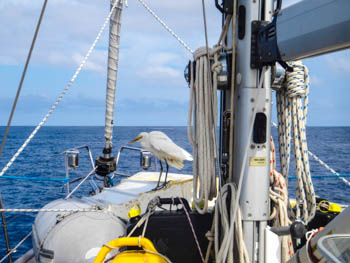
It was a cattle egret! What was he doing 50 miles from shore? He sashayed casually about the boat with his long spindly legs and enormous non-webbed feet. He was a curious thing, looking into the open window, trying to step through, strutting along the deck, peering into the bucket, hopping up onto the combing...
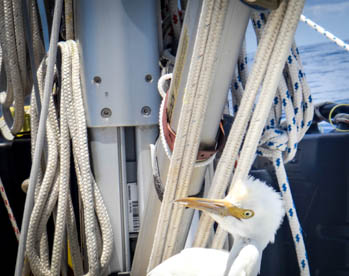


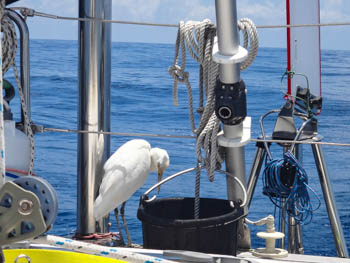
When we changed course to head more northerly and directly to Palau, Jim wondered if we should boot him off so he could find an island. We still weren't too far from some. I figured he would go when he wanted to.
That night he hunkered down on the windward side of the deck alongside the cockpit in the spot just before it narrows for the port side winch. He was protected on two sides and stayed there all night. We crossed the equator while he slept.
In the morning he wandered around again but more slowly. He flapped his wings to hop up on the coachroof like he had before, but a gust of wind caught him and he was gone. I looked behind but did not see him. Then I did. He was flying towards the stern. He dipped down and tried to land on the windvane but must have fallen off because I saw him sitting in the water. He rose up and tried to fly to the boat again. This time I slowed Tenaya down. "Come on, you can do it, come on," I urged him out loud. As he neared his flight got really wobbly. He tried to land on the windvane again but fell off again. This time he just sat in the water and did not try to fly. He must have been completely exhausted. I watched him get smaller until I couldn't see him anymore. Jim came up because he heard the change in the RPMs. "What's up?" he asked. My voice cracked as I told him.
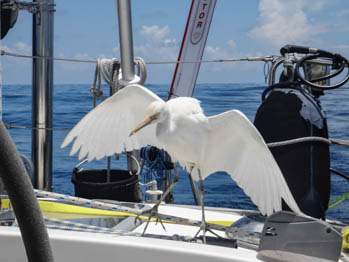
That night at dusk a red-footed booby landed on the pulpit. He stayed there all night and flew away at dawn. What a mess he left on the bowsprit!
On Day Five I was sitting at the chart table typing a message when Jim asked, "Did a little bird just fly down there?" I looked around but did not see anything. "Nope." When I went to hit the backspace key, there it was! A small bird was sitting right there on the edge of my computer with its eyes closed.

"Oh yeah," I called to Jim, "he's on my computer!" I grabbed my camera and took some photos. It didn't bother him a bit. I think he was asleep. He couldn't stay below all night so I put him in a Tupperware box with a towel and took him out to the cockpit. He immediately jumped out and hopped up as close as he could to the windscreen. He settled onto a strap on a flare and stayed there during the night.
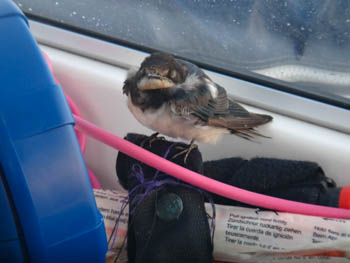
In the morning he hopped around and then flew away and returned several times. At one point he was sitting on a lifeline and another bird just like him flew around the radar pole but did not land. I think they were some sort of storm petrels but I couldn't find one described exactly like them in my Seabirds Identification Guide.
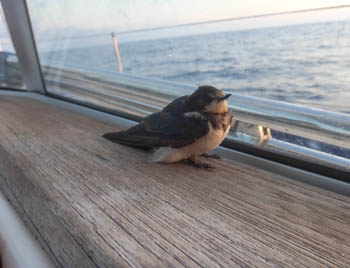
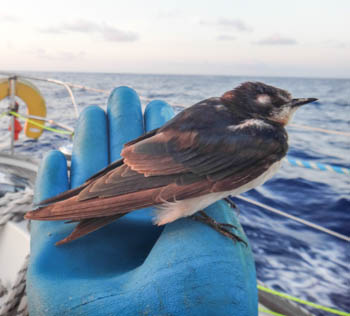

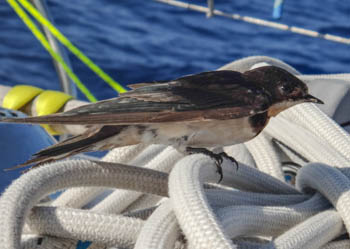
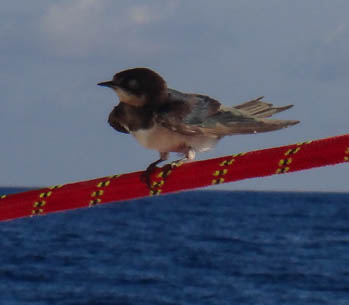
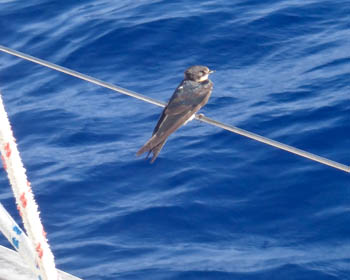
He was sitting on the dinghy and then he wasn't. I thought he'd flown away. There was a squall during the night with heavy rain. As dawn broke I saw him lying on the deck. No, I thought, not again. But he was definitely dead. I waited until Jim came on watch at 0700 to measure him. Then I dropped him overboard.
On Day Seven another storm petrel visited. He flew into the cockpit, perched on Jim's Kindle and looked at him, then flew down inside. He fluttered around looking for a place to land and then flew out the smallest window. He came back and perched on the same window. I shooed him away. I'd had enough of birds dying. I was happy he did not return.
We left Jayapura on October 17 at 0900. Our plan was to sail parallel to the coast for about 350 miles until we reached 135E, the longitude of Palau. Then head due north for about 500 miles. That way, if another typhoon came, we could duck into Biak or Manokwari in Indonesia to wait it out.
Winds were light from the west and the sea was slight. The current was against us as and our Speed Over Ground (SOG) was about three knots. It would take forever to get to Palau at this speed!
As we plodded along a small outriggered fishing boat approached us. When it reached us the two guys waved and then headed off towards Jayapura.

There were a lot of logs in the water. Hundreds. We dodged dozens. There were also big, floating drums. Some were painted with numbers and letters, others were not. We were happy to have the full moon to help see the bigger hazards. Even so, we felt things bump the hull a few times.
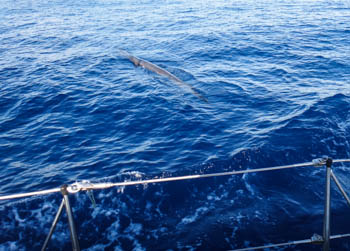



On Day Four the winds were still light so we altered our plan and made a beeline for Palau. Cutting the corner would save us some time and miles.
On Day Six the wind picked up to 10 knots. We were finally sailing! The seas were still slight and there were hardly any clouds in the sky.
On Day Seven we had to reef the sails to arrive at the pass through the outer reef at Palau in daylight. The current had been against us the entire trip.
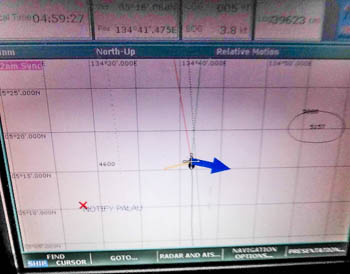
On Day Eight I stood at the bow as we motored through the pass in the outer reef and by the rounded green islands. The water was shallow and turquoise on either side of the channel but deeper blue down the center as we negotiated the inner reefs. They are well marked. We reached the Commercial Dock at 1026 on October 24. UN Day. A holiday. We expected to pay overtime fees to each of the officials but nobody brought up the subject.
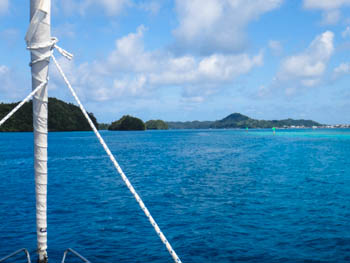
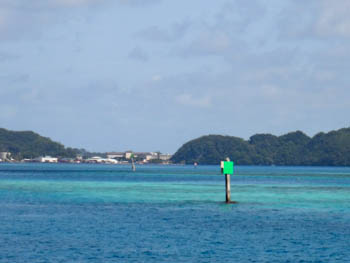
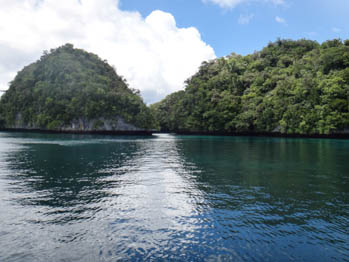
Some folks must have had trouble tying up to the concrete dock because a rope handler was provided whether we wanted him or not. A man from the Dept. of Transportation came first and we paid him $60 for some sort of port fee and $20 for the line handler. Then the Customs official came. He did not take money but told us to go to their office the following day and pay the water tax. Then the Immigration official came and filled out some forms and stamped our passports. He charged us $50 but we only had $20 bills so he said he'd bring our Harbor Permit and the $10 change to Sam's Tours. That's where we would be moored. We were off the dock in less than an hour.
As we motored around Malakal Island we saw the first American flag flying off a vessel since Sydney. There was a US warship anchored in the bay! As we rounded another turn we saw the anchorage in front of Sam's Tours and, finally, yachts.
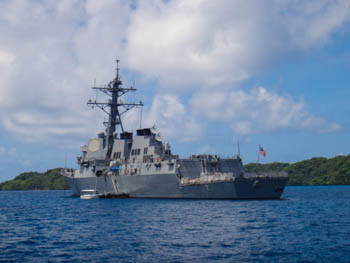
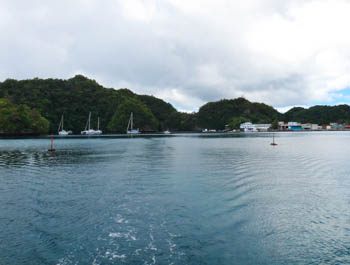
Laura on Zen is the treasurer for the Royal Belau Yacht Club and met us at the mooring we would rent for three months. When we went ashore later in the afternoon, she introduced us to Joan and Tom on Toucan. While drinking beers together they invited us to dinner. It felt good to walk and better to eat someone else's cooking.

For $7.00 each we had heaping plates of food at a restaurant called Carp. We realized we are far, far away from the remote islands of Papua New Guinea.
Go to November 2013 Part One - Cheeseburgers and Typhoons in Palau
